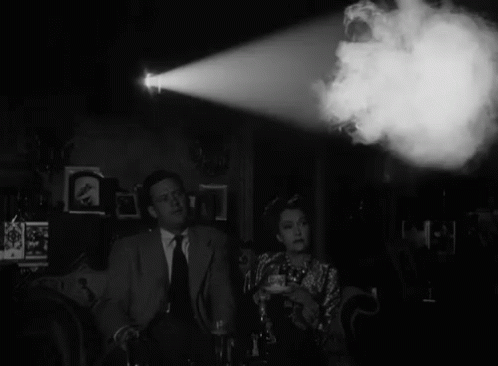From the Editors, October 2018
The polarities of darkness and light are central to many parts of the cinematic process, from the capturing of images onto photosensitive film to the projection of those images in exhibition halls through history and around the world. Laurent Mannoni describes the cinema as "the great art of light and shadow."1 We like to think of cinema as a dance of light and shadow. Cinema is a dance of light in a darkened room. This dance is created by beams of light that are obscured by flickering film strip travelling at 24 frames per second. Cinematic images appear before us when this light is temporarily obscured by the shadow of each frame.
Light, shadow, cinema.
It is this dance of light and shadow that entrances us; it produces images that stick in our memories as we hold onto our favourite cinematic moments; it is central to the way we understand the power of cinema. Light and shadow were also central to film's apparatus theorists Jean-Louis Baudry and Alan Williams, for whom "the arrangement of the different elements--projector, darkened room, screen," reproduced "the mise-en-scene of Plato's cave" and reconstructed the Lacanian 'mirror stage' to great effect. 2 While Peephole Journal's editors and writers are not always hardcore fans of psychoanalytic film theory, we too seek to understand the power of light and shadow as it dances on screen before us. Flickering between these polarities of light and darkness, this issue of Peephole Journal features seven essays. Joanna Batsakis, Emma Downey and Tom Vincent focus primarily on the theme of light. Joanna examines the kinetic beauty of Walter Salles' adaptation of On the Road (2012), Emma draws light, darkness and movement into her analysis of the key dance sequence of Anna Karenina (Joe Wright, 2012), and Tom explores Pierrot the clown's rapture with luminescence in Kenneth Anger's Rabbit's Moon (1972/1979). In the remaining four essays, Athena Bellas, Felicity Chaplin, Soham Gadre, and Ammar Keshodia take their distinct perspectives to the theme of shadow. Felicity and Athena both focus on figures of femininity emerging from the shadows. For Felicity, this is Charlotte Gainsbourg's appearance in the music video for 'Les Oxalis' and for Athena this is a transgressive girlhood emerging from the shadows in Ana Lily Amirpour's A Girl Walks Home Alone At Night (2014). In contrast to this, Soham writes on disappearance into shadow in Lav Diaz's The Woman Who Left (2016) while Ammar explores Lee Chang-dong's Poetry (2010) and the embrace of darkness as a thematic.
We are particularly pleased to feature this mix of voices with returning contributors and new writers for our latest issue.
Whitney, Belinda and Kate

